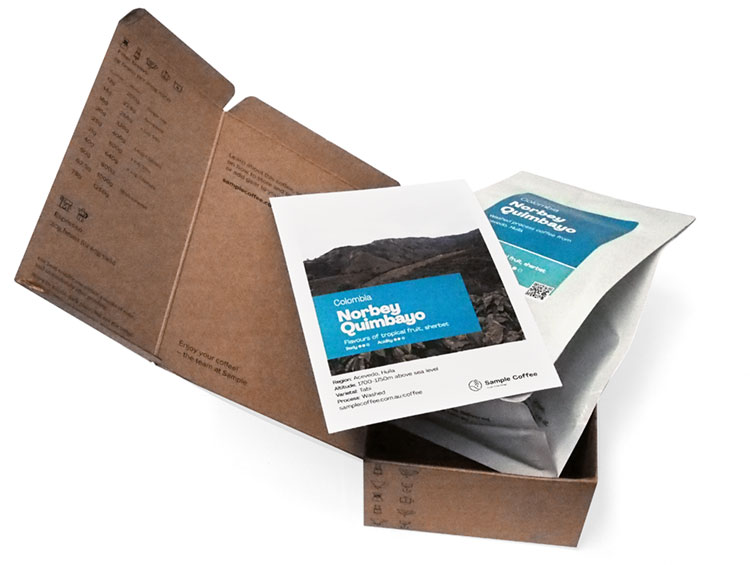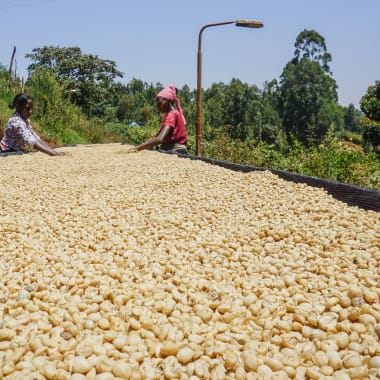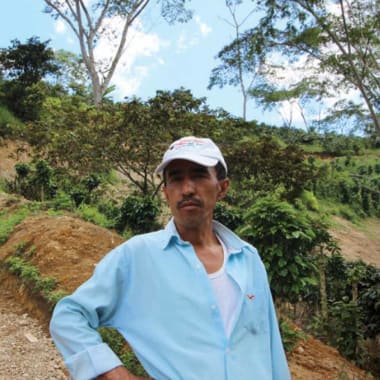-
Producer
-
Maria Elena Vides De Ovalle
-
Country
- Guatemala
-
Region
-
Huehuetenango
-
Altitude
-
1250 - 1520m above sea level
-
Varieties
-
Process
-
Harvested
-
March 2016
-
Importer
-
Silo
-
Body
-
Medium
-
Acidity
-
Medium
-
Tasting notes
-
Toffee, cherry, creamy
-
Roast style
Guatemala
Peña Blanca
You might have heard that great coffee harvests come from areas with diverse microclimates, and this coffee is a fine example.
Peña Blanca (White Rock) is a small section of Finca La Bolsa, a farm that we’ve featured several times recently. The farm is located near La Libertad, on some steep slopes in Guatemala’s Huehuetenango region.
María Elena Vides de Ovalle and her son Renardo Ovalle have decided to allow each combination of terrain, altitude and microclimate to speak for themselves by keeping each lot separate through all the processing stages so they can be roasted and tasted individually.
We’ve already featured several different lots of coffee from La Bolsa: Rincon at the end of 2016, Los Encuentros which we shared in 2015; and also La Huerta and La Libertad, which we’ve featured in our cafes previously. It’s great to see such variety and high quality coming from one farm, and it’s the result of the work María and Renardo put into managing the farm.
 María Elena Vides de Ovalle and Renardo Ovalle (Snr)
María Elena Vides de Ovalle and Renardo Ovalle (Snr)
Coffee was first planted at La Bolsa by Dr Jorge Vides in 1958, with María Elena Vides de Ovalle and her son Renardo Ovalle now owning and managing the farm.
Two rivers run across the property and provide the water for processing the coffee, hydroelectricity for the farm as well as supplying surplus water to the nearby La Mesilla municipality.
 The view from the coffee plantation down to the wet mill and drying areas
The view from the coffee plantation down to the wet mill and drying areas
In the photos from the farm, you can see the sort of terrain where the coffee is grown, and then picked by hand before being carried down to the wet mill for processing.
 New plantations in the foreground, and again the wet mill and drying areas in the background.
New plantations in the foreground, and again the wet mill and drying areas in the background.
Bourbon
This coffee is a combination of both the Caturra varietal and bourbon varietal of coffee, together they’re two of the most commonly seen varietals of arabica coffee.
Thought to originate on the Island of Bourbon (now Réunion Island) off Madagascar, bourbon grew out of mutations of Ethiopian and Yemeni arabica plants.
These plants were then further cultivated in Brazil, before they were transported back to East Africa. Bourbon is now most often associated with coffee crops in Rwanda and Burundi.
The video below tells the entertaining journey of how bourbon came to be, from James Hoffman’s talk at the 2014 UK Barista Championships.
If you haven’t already picked up a copy of his book The World Atlas of Coffee, trust us when we say it’s worth your time. James is managing director of the UK roaster Square Mile, a former world barista champion and also blogs and tweets his thoughts on coffee.
Learn everything about this coffee:
Ethical, traceable sourcing
This page has all the sourcing information (variety, process, region, story, importer, and more) that our importers share with us, and give us permission to use.
The transparency helps us talk confidently about the quality and background of our product, and it helps you know exactly what you’re buying.
Learn more:
Coffee page transparency legend
Our coffee philosophy
Our business approach
Fresh harvest coffee
We only source and roast coffee from each country’s latest harvest season (so the green coffee is never older than 1 year from the time of picking, processing and packing). This ensures the sensory qualities are always at their peak and unaffected by excessive ageing.
Roasted for espresso and filter (best enjoyed black)
Roast style: omni. Omni roasts are designed to brew and taste great both as espresso and filter. Our omni single origins generally sit on Agtron values in the ~70-60 value range. So, technically, they are somewhere in the lighter side of the medium spectrum.
Designed for espresso and filter brewing. Best enjoyed black.
Learn more:
Our Loring Kestrel S35 roaster
Our roasting style and approach
Best brewed within days 15-49 post-roast
The ‘fresh is best’ saying doesn’t apply to coffee (contrary to popular belief). Waiting before opening and brewing your bag of whole coffee beans helps develop peak flavour and acidity.
But heads up: if you buy pre-ground coffee, brew it as soon as possible.
Learn more:
Our recommended brewing window
Try our custom brewing recipes
Our recipes and ratios are tailored to our coffee sourcing and roasting styles, bringing the best flavour and feel out of each coffee.
For pour over, immersion, and other filter brewing styles, check our brew guides.
For our espresso single origins, we recommend a coffee:yield ratio of 1:3:
- Dose: 20g ground coffee
- Yield: 60g espresso
- Total brew time: ~24-28 seconds
This is just a starting point! We encourage you to experiment, taste, and adjust to find the recipe that you enjoy the most.
Learn more:
Our espresso brew guide (single origin)
Brewing ratio calculator
Packaging and sustainability
- Bags: ABA-certified home compostable (AS 5810-2010)
- Labels: recyclable
- Valves (only on +250g bags): general waste
- Box and tape (online orders): recyclable
Learn more:
Our packaging
Varieties
Bourbon variety
A natural mutation of the Typica varietal, Bourbon is named after Reunion Island (then known as Il Bourbon) where the French cultivated the Typica plants which naturally mutated.
Caturra variety
Caturra is a natural mutation of Bourbon that was originally discovered in Brazil in 1937, considered to be the first naturally occurring mutation ever discovered.
The location
Coffee from Guatemala
Guatemala’s production of coffee first grew in the 1860s on the back of a declining indigo trade, which had previously existed as it’s main export. Up until 2011 Guatemala was in the top 5 highest producing coffees nations in the world, before being overtaken by Honduras.
The Huehuetenango region of Guatemala
A non-volcanic region of Guatemala characterised by high altitude and predictable climate. Often considered to produce the highest quality coffee in Guatemala
Farm processes
Washed process
Machines are used to remove the flesh from the coffee cherry before being fermented in water, washed again, and finally sun dried. This process tends to result in more distinct, cleaner flavours.
1 brew note from subscribers
Guatemala Peña Blanca
Paul’s V60
- 30g
- 450ml

Subscribe to a world of coffee
Discover a new single origin coffee from Sample every 1-5 weeks with no delivery fees.
No up-front purchase, and you can pause, cancel, or change plans at any time.
Available to order online this week:

Colombia Carlos Imbachi Pink Bourbon
Flavours of pear, jasmine, sugarcane
Body Acidity
Washed Pink Bourbon
February 2025 harvest
Roasted omni for filter and espresso
Colombia Carlos Imbachi Pink Bourbon online
Ethiopia Girma Sintayehu Honey
Flavours of apricot, mango, coconut, pineapple
Body Acidity
Honey 75227, Wolisho
February 2025 harvest
Roasted omni for filter and espresso
Ethiopia Girma Sintayehu Honey online
Kenya Karindundu Aa
Flavours of orange marmalade, grapefruit, Yunnan red tea
Body Acidity
Washed Batian, SL28, SL34, Ruiru 11
Roasted omni for filter and espresso
Kenya Karindundu Aa online
Colombia Jose Elcias Martinez Guzman Pink Bourbon
Flavours of mandarin, burnt orange, pineapple
Body Acidity
Washed Pink Bourbon
December 2024 harvest
Roasted omni for filter and espresso
Colombia Jose Elcias Martinez Guzman Pink Bourbon online